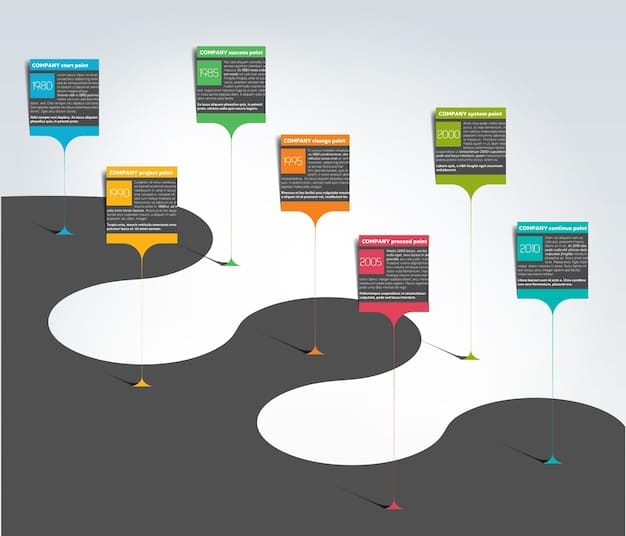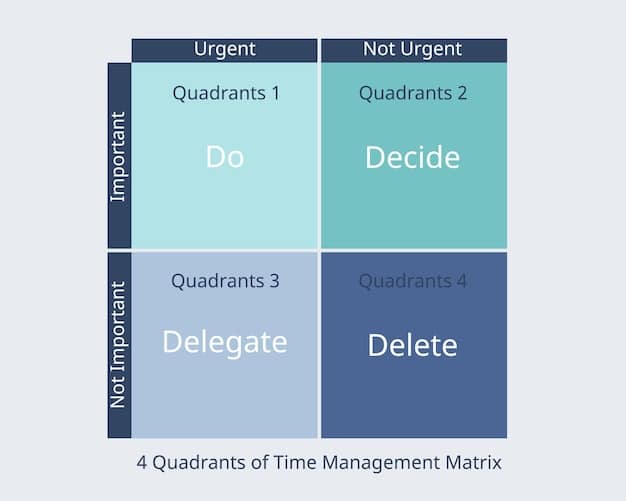The 5 Biggest Task Management Mistakes US Companies Make in 2025

The 5 Biggest Task Management Mistakes US Companies Make in 2025 often revolve around poor planning, inadequate communication, lack of prioritization, not utilizing the right tools, and failing to adapt to changing circumstances, all of which can significantly hinder productivity and profitability.
Navigating the complexities of task management can be challenging, and US companies often stumble into common pitfalls. Understanding and avoiding these mistakes is crucial for optimizing productivity and achieving strategic goals. Let’s delve into The 5 Biggest Task Management Mistakes US Companies Make (and How to Avoid Them) in 2025.
Common Task Management Mistake #1: Poor Planning & Goal Setting
Effective task management starts with solid planning. Without clear goals and a well-defined strategy, companies risk wasting time and resources on tasks that don’t contribute to overall objectives. This sets the stage for inefficiency and missed opportunities.
Goal setting is integral to planning. When objectives are unclear or not communicated effectively, employees struggle to prioritize tasks, leading to a lack of focus and reduced productivity. This is where a structured approach can make a significant difference.
Setting SMART Goals
One proven method for effective goal setting is the SMART framework, which ensures goals are Specific, Measurable, Achievable, Relevant, and Time-bound. Applying this method helps companies define objectives more clearly.
Creating Detailed Action Plans
An action plan outlines the steps needed to achieve a goal, assigning responsibilities and setting deadlines for each task. This provides a roadmap for teams to follow, minimizing confusion and maximizing efficiency.
- Clearly define the overarching goals and break them down into smaller, manageable tasks.
- Assign specific individuals or teams to each task, ensuring accountability and ownership.
- Set realistic deadlines for each task, aligning them with the overall project timeline.
- Regularly review and adjust plans as needed, adapting to changing circumstances and feedback.

By implementing structured planning and goal-setting processes, US companies can avoid the first major pitfall of task management. With a clear roadmap, teams are better equipped to focus on the right tasks, driving productivity and achieving strategic objectives.
Common Task Management Mistake #2: Inadequate Communication
Communication is the lifeblood of any successful project. When communication is lacking, misunderstandings can arise, deadlines can be missed, and overall team performance suffers. Inadequate communication is a silent killer of productivity and efficiency.
Misunderstandings lead to errors and rework, further delaying project completion. Poor communication can also damage team morale, as employees feel uninformed and undervalued. Open and transparent communication, on the other hand, fosters trust and collaboration.
Establishing Communication Channels
Choosing the right communication channels is essential. Whether it’s email, instant messaging, or regular meetings, each channel serves a unique purpose. It’s crucial to establish clear guidelines for when and how to use each one.
Encouraging Transparent Dialogue
Creating an environment where team members feel comfortable sharing ideas, concerns, and updates is critical. This requires a culture of trust and openness, where feedback is valued and acted upon.
- Implement regular team meetings to discuss progress, challenges, and upcoming tasks.
- Use project management software with built-in communication features to keep everyone informed.
- Encourage team members to provide regular updates on their tasks, highlighting any potential roadblocks.
- Foster a culture of open feedback, where constructive criticism is welcomed and used to improve performance.
By emphasizing open and transparent communication, US companies can ensure that everyone is on the same page. This minimizes misunderstandings, promotes collaboration, and ultimately drives better task management outcomes.
Common Task Management Mistake #3: Lack of Prioritization
Prioritization is the art of focusing on what matters most. Without a clear understanding of which tasks are most critical, companies risk spreading their resources too thin, leading to inefficiency and missed deadlines. Lack of prioritization can derail even the best-laid plans.
When everything seems equally important, it’s easy to get bogged down in less critical tasks, neglecting those that have the greatest impact. Proper prioritization ensures that resources are allocated to the tasks that align with strategic objectives, maximizing overall effectiveness.
The Eisenhower Matrix
The Eisenhower Matrix, also known as the Urgent-Important Matrix, is a tool for prioritizing tasks based on their urgency and importance. This helps to distinguish between tasks that need immediate attention and those that contribute to long-term goals.
Using Time Blocking Techniques
Time blocking involves scheduling specific blocks of time for particular tasks, ensuring that focused effort is directed toward high-priority items. This technique helps to eliminate distractions and improve concentration.
- Identify tasks that are crucial to achieving strategic objectives and prioritize them accordingly.
- Use the Eisenhower Matrix to categorize tasks based on their urgency and importance.
- Allocate specific blocks of time for high-priority tasks, minimizing distractions and maximizing focus.
- Regularly review and adjust priorities as needed, adapting to changing circumstances and emerging opportunities.

By implementing effective prioritization strategies, US companies can ensure that their resources are focused on the most critical tasks. This leads to increased efficiency, improved productivity, and better alignment with strategic objectives.
Common Task Management Mistake #4: Not Utilizing the Right Tools
In today’s digital age, numerous task management tools are available to streamline processes and enhance productivity. Failing to leverage these tools can put companies at a significant disadvantage. Choosing the right tools is essential for optimizing task management.
Not all tools are created equal, and what works for one company may not work for another. It’s crucial to assess specific needs and requirements before selecting a task management platform. The right tools can automate processes, improve collaboration, and provide real-time visibility into project progress.
Exploring Task Management Software
Task management software offers a range of features, including task assignment, deadline tracking, and progress monitoring. These tools can significantly improve team coordination and accountability.
Leveraging Automation Features
Automation features can streamline repetitive tasks, freeing up employees to focus on more strategic activities. This includes automated reminders, status updates, and report generation.
- Evaluate different task management tools based on company size, project complexity, and team preferences.
- Choose a tool that integrates seamlessly with existing systems and workflows.
- Provide comprehensive training to employees on how to use the selected task management tool effectively.
- Regularly review and update task management tools to ensure they continue to meet evolving needs.
By adopting the right task management tools, US companies can streamline processes, improve collaboration, and boost overall productivity. The key is to select tools that align with specific needs and provide the features necessary to optimize task management efforts.
Common Task Management Mistake #5: Failing to Adapt to Changing Circumstances
The business landscape is constantly evolving, and task management strategies must adapt to remain effective. Rigidity and resistance to change can lead to inefficiency and missed opportunities. Adaptability is key to long-term success.
New technologies emerge, market conditions shift, and project requirements evolve. Companies that fail to adapt their task management practices risk falling behind. Flexibility, on the other hand, enables them to respond quickly to new challenges and capitalize on emerging opportunities.
Implementing Agile Methodologies
Agile methodologies emphasize iterative development, frequent feedback, and continuous improvement. This approach allows teams to adapt quickly to changing requirements and deliver value more efficiently.
Embracing a Growth Mindset
A growth mindset encourages employees to view challenges as opportunities for learning and development. This fosters a culture of continuous improvement, where new ideas are welcomed and experimentation is encouraged.
- Adopt agile methodologies to promote flexibility and responsiveness in task management.
- Establish processes for regularly reviewing and updating task management strategies.
- Encourage employees to embrace a growth mindset, viewing challenges as opportunities for learning.
- Foster a culture of continuous improvement, where feedback is valued and used to refine processes.
By embracing adaptability, US companies can ensure that their task management practices remain effective in the face of change. This involves implementing agile methodologies, fostering a growth mindset, and establishing processes for continuous improvement.
| Key Point | Brief Description |
|---|---|
| 🎯 Poor Planning | Unclear goals lead to inefficiency; use SMART goals. |
| 🗣️ Inadequate Communication | Misunderstandigs cause delays; establish clear channels. |
| ⌛ Lack of Prioritization | Resources spread too thin; utilize the Eisenhower Matrix. |
| 🛠️ Wrong Tools | Productivity suffers; choose tools aligned with needs. |
Frequently Asked Questions
▼
The most significant mistake is poor planning. Without clear goals and strategies, tasks become unfocused, leading to wasted resources and missed deadlines.
▼
Communication ensures everyone is on the same page. Lack of it leads to misunderstandings, errors, and delays, impacting team morale and overall project success.
▼
Use tools like the Eisenhower Matrix to categorize tasks by urgency and importance. Allocate time blocks for high-priority activities to ensure focus and efficiency.
▼
Task management software improves team coordination, automates repetitive tasks, and provides real-time visibility into project progress, enhancing overall productivity.
▼
The business environment is dynamic. Adaptability allows companies to quickly respond to changes, embrace new technologies, and maintain effective task management practices.
Conclusion
Avoiding these five common task management mistakes can significantly enhance productivity and efficiency in US companies. By focusing on clear planning, open communication, effective prioritization, the right tools, and adaptability, businesses can optimize their task management practices and achieve strategic objectives.





